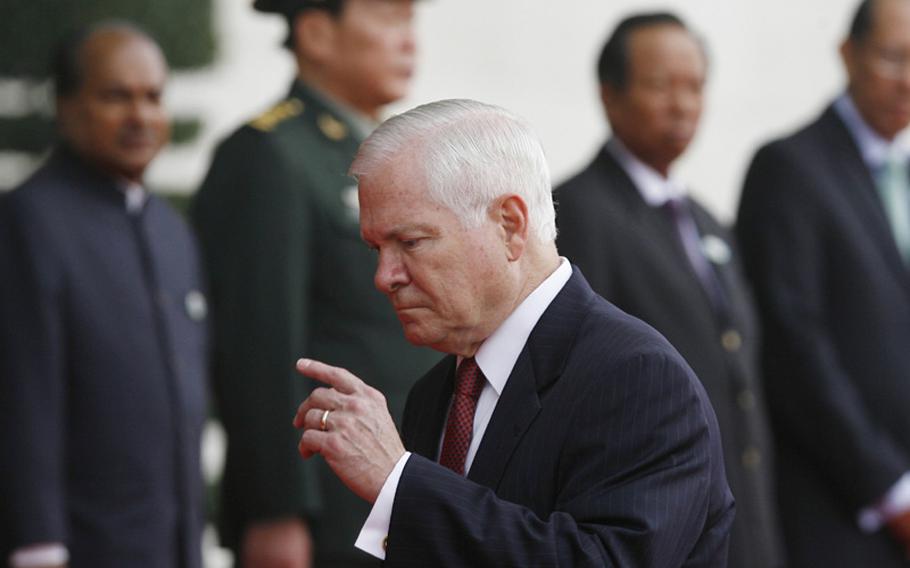Migration
Gates: Intelligence underestimated Chinese stealth progress
Stars and Stripes January 9, 2011

In this Oct. 12, 2010, file photo, U.S. Defense Secretary Robert Gates attends the Association of Southeast Asian Nations (ASEAN) Defense Ministers Meeting Plus in Hanoi, Vietnam. Gates said Sunday that U.S. intelligence underestimated how fast China was developing a stealth-capable fighter, but gave reassurance he has been monitoring its progress. (Kham/AP/Pool)
ABOARD A MILITARY AIRCRAFT — Defense Secretary Robert Gates said U.S. intelligence underestimated how fast China was developing a stealth-capable fighter, but gave reassurance he has been monitoring its progress.
Grainy images and video of what appears to be a prototype Chinese stealth fighter appeared online in recent weeks. Additionally, the top military commander in the Pacific said last month China’s widely anticipated anti-ship ballistic missile system had reached “initial operational capability,” an important last milestone before being ready for deployment. Last week, the top U.S. naval intelligence officer said intelligence underestimated that system’s progress, as well.
Critics have questioned whether the United States was caught flat-footed by either development.
“We’ve been watching these developments all along,” Gates told reporters aboard his plane, which arrived in Beijing on Sunday. “I’ve been concerned about the development of the anti-ship cruise and ballistic missiles ever since I took this job. We knew they were working on a stealth aircraft.
“I think that what we’ve seen is that they may be somewhat further ahead in the development of that aircraft than our intelligence had earlier predicted.”
Some military experts have questioned whether the plane in the images has stealth capability. Its angled tail fins resemble U.S. stealth aircraft, but the plane appears much larger than advanced, or fifth-generation, fighters.
The aircraft has rekindled debate about Gates’ controversial 2009 decision to end production of the most advanced U.S. fighter ever built, the stealth F-22 Raptor, and slow purchases of the F-35. Critics point to China’s long-known race for stealth aircraft as a threat to U.S. air superiority. But Gates, at the time, said China would not have advanced-generation fighters for another decade and the realistic chances of an air-to-air war with other nations did not trump the hardware needs for fighting in Afghanistan in Iraq.
“I never said that — as somebody quoted me — that their stealth aircraft didn’t matter,” Gates said Saturday. “What I said was that in 2020 or 2025 that there would still be a vast disparity in the number of deployed fifth-generation aircraft that the United States had compared to anybody else in the world. And I continue to stand by that statement.”
Gates also noted that his defense budget cuts announcement earlier this week gave higher priority to U.S. investments focused on countering the “anti-access programs” China is developing, such as a new long-range bomber, ship-borne electronic jammers and surveillance aircraft.
Gates’ comments reflect the sensitive mission of his trip: to build a “sustained and reliable” military-to-military relationship with Beijing.
Gates said he would “look for ways to expand the relationship … see if we can come to an agreement on developing a strategic dialogue that talks about strategy and policies and, perhaps, outlooks.”
“I’ve believed for a long time that that kind of a dialogue … contributes to avoiding miscalculations and misunderstandings and miscommunication.”
When one reporter noted Gates made very similar statements before his 2007 visit, Gates quipped, “I remember.”
This time is different, he said, because China helped ease tensions on the Korean peninsula last month — North Korea did not retaliate against the latest South Korean military exercises as it had threatened — and Beijing asked for the visit clearly to smooth relations for the following week’s presidential summit in Washington between Hu Jintao and Barack Obama
Gates said he would like to move forward on seven areas in which the Chinese agreed to increase cooperation in 2009 but have been “on hold ever since,” including more high-level visits, exercises and exchanges with the People’s Liberation Army.
“One of our goals is to see if we can get out ahead of these periodic provocations by the North Koreans and bring greater stability to the peninsula. We both have, we have a mutual interest in that,” Gates said, “And let’s see if we can’t move forward with North Korean denuclearization and some of the other things that they could do that would open the way for further progress.”